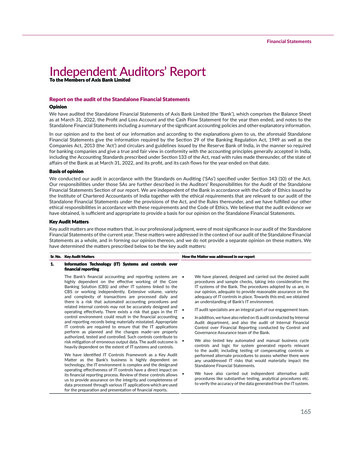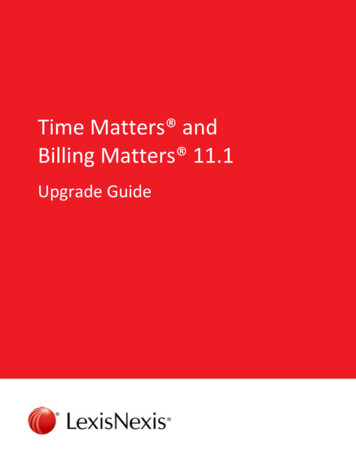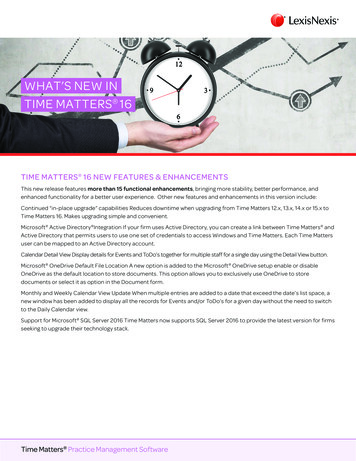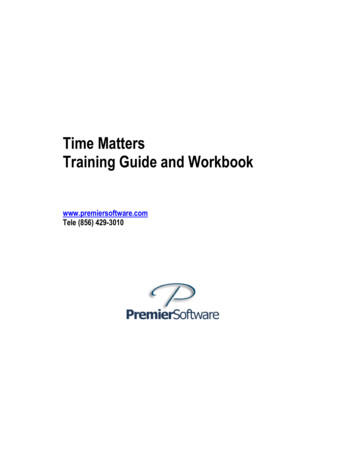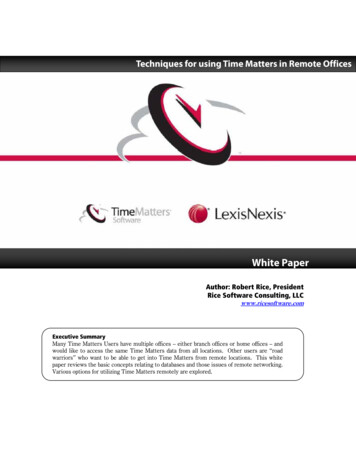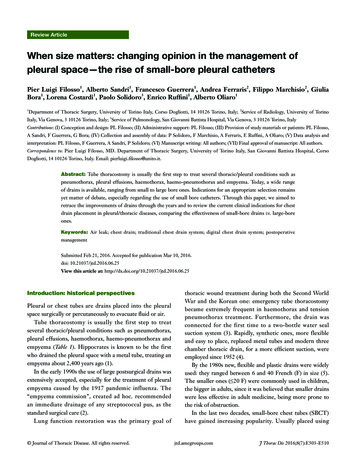
Transcription
Review ArticleWhen size matters: changing opinion in the management ofpleural space—the rise of small-bore pleural cathetersPier Luigi Filosso1, Alberto Sandri1, Francesco Guerrera1, Andrea Ferraris2, Filippo Marchisio2, GiuliaBora1, Lorena Costardi1, Paolo Solidoro3, Enrico Ruffini1, Alberto Oliaro11Department of Thoracic Surgery, University of Torino Italy, Corso Dogliotti, 14 10126 Torino, Italy; 2Service of Radiology, University of TorinoItaly, Via Genova, 3 10126 Torino, Italy; 3Service of Pulmonology, San Giovanni Battista Hospital, Via Genova, 3 10126 Torino, ItalyContributions: (I) Conception and design: PL Filosso; (II) Administrative support: PL Filosso; (III) Provision of study materials or patients: PL Filosso,A Sandri, F Guerrera, G Bora; (IV) Collection and assembly of data: P Solidoro, F Marchisio, A Ferraris, E Ruffini, A Oliaro; (V) Data analysis andinterpretation: PL Filosso, F Guerrera, A Sandri, P Solidoro; (VI) Manuscript writing: All authors; (VII) Final approval of manuscript: All authors.Correspondence to: Pier Luigi Filosso, MD. Department of Thoracic Surgery, University of Torino Italy, San Giovanni Battista Hospital, CorsoDogliotti, 14 10126 Torino, Italy. Email: pierluigi.filosso@unito.it.Abstract: Tube thoracostomy is usually the first step to treat several thoracic/pleural conditions such aspneumothorax, pleural effusions, haemothorax, haemo-pneumothorax and empyema. Today, a wide rangeof drains is available, ranging from small to large bore ones. Indications for an appropriate selection remainsyet matter of debate, especially regarding the use of small bore catheters. Through this paper, we aimed toretrace the improvements of drains through the years and to review the current clinical indications for chestdrain placement in pleural/thoracic diseases, comparing the effectiveness of small-bore drains vs. large-boreones.Keywords: Air leak; chest drain; traditional chest drain system; digital chest drain system; postoperativemanagementSubmitted Feb 21, 2016. Accepted for publication Mar 10, 2016.doi: 10.21037/jtd.2016.06.25View this article at: ion: historical perspectivesPleural or chest tubes are drains placed into the pleuralspace surgically or percutaneously to evacuate fluid or air.Tube thoracostomy is usually the first step to treatseveral thoracic/pleural conditions such as pneumothorax,pleural effusions, haemothorax, haemo-pneumothorax andempyema (Table 1). Hippocrates is known to be the firstwho drained the pleural space with a metal tube, treating anempyema about 2,400 years ago (1).In the early 1990s the use of large postsurgical drains wasextensively accepted, especially for the treatment of pleuralempyema caused by the 1917 pandemic influenza. The“empyema commission”, created ad hoc, recommendedan immediate drainage of any streptococcal pus, as thestandard surgical care (2).Lung function restoration was the primary goal of Journal of Thoracic Disease. All rights reserved.thoracic wound treatment during both the Second WorldWar and the Korean one: emergency tube thoracostomybecame extremely frequent in haemothorax and tensionpneumothorax treatment. Furthermore, the drain wasconnected for the first time to a two-bottle water sealsuction system (3). Rapidly, synthetic ones, more flexibleand easy to place, replaced metal tubes and modern threechamber thoracic drain, for a more efficient suction, wereemployed since 1952 (4).By the 1980s new, flexible and plastic drains were widelyused: they ranged between 6 and 40 French (F) in size (5).The smaller ones ( 20 F) were commonly used in children,the bigger in adults, since it was believed that smaller drainswere less effective in adult medicine, being more prone tothe risk of obstruction.In the last two decades, small-bore chest tubes (SBCT)have gained increasing popularity. Usually placed usingjtd.amegroups.comJ Thorac Dis 2016;8(7):E503-E510
E504Table 1 Indications for chest drain insertionIndications for chest tube insertionPneumothoraxIn any ventilated patientTension pneumothoraxPersistent/recurrent pneumothoraxSecondary large pneumothorax (especially in 50 years old patients)Malignant pleural effusions ( pleurodesis)Pleural empyema and complicated parapneumonic effusionsTraumatic haemo-pneumothoraxPost-surgery (lung resection, cardiac surgery, oesophagectomy)the Seldinger technique, sometimes under radiologicalguidance, they were initially used to drain abdominalcollections and subsequently also pleural effusions. SBCTsquickly gained popularity between surgeons, pulmonologistsand oncologists, being easier to position and characterizedby less pain to the patient, becoming the actual standard ofcare in several clinical conditions.The aim of this paper is to review the current clinicalindication for chest drain placement in pleural/thoracicdiseases, comparing the effectiveness of small-bore andlarge-bore ones.What size chest drain?Chest drains are usually divided into size categories accordingto their size: large-bore ( 20 F) or small-bore ( 20 F). F isa standardized unit of measurement which was proposedby the French surgical instrument maker Joseph-FredericBenoit Charrière, in 1860. F refers to the outer diameter of acylindrical tube and it is equivalent to 0.333 mm.Like all cylindrical tubes, pleural drains too obey toPoiseuille’s law and the Fanning equation.The Fanning equation (ν π2r5P/fl, were ν is the flow, rthe radius, l the length, P the pressure and f the frictionfactor) regulates the moist gas (such as in a pneumothorax)or liquid with turbulent flow through the tube (6). ThePoiseuille’s law (ν πr4.ΔP/8.ὴL, were ν is the flow, r theradius, ὴ the liquid’s viscosity, L the tube’s length and ΔPthe difference between the tube’s ends) regulates the flow ofcorporeal fluids.The internal diameters (bore), which may vary accordingto the manufacturer and the length of the tube, areobviously key determinants of pleural fluid flow (includingblood and pus). Therefore, for an appropriate selection of Journal of Thoracic Disease. All rights reserved.Filosso et al. Small-bore catheters in thoracic surgerythe chest drain both the quality of the drained material aswell as its formation rate should be taken in account. If weconsider viscous fluids rapidly generated (such as blood ina traumatic patient), a large-bore chest tube (LBCT) seemsto be more effective rather than a small-bore one, whichis, contrariwise, adequate when a similar volume of air isproduced (e.g., pneumothorax).An experimental study compared the drainage capacityof a 19-F vs. a 28-F tube in vivo and in vitro, showing thatthe larger one had an in vitro capacity 9 times higher thanthe other, whilst, in vivo, both tubes had the same drainagecapability over time (7). Similar results were also found byPark and Colleagues, who compared the catheters drainagetime according to their size, taking into account thecharacteristics of fluid, including viscosity (8). In their study,the authors observed that the tube’s size was significantlydifferent only for catheters smaller than 8 F, while it was notso for the larger ones. Furthermore, the size of the drainfenestrations should be considered for the tube drainagecapability, but at present no studies evaluating this factorare available in literature.Large-bore drainsTraditionally, large-bore tubes are employed whenever ahigh-risk of drain obstruction is expected, such as in case ofempyema or active bleeding, even if this fact has never beendemonstrated by randomized clinical trials. The presence ofmultiloculated pleural collections with high viscosity liquid,typical of stage II–III pleural empyema, make the simpletube thoracostomy often ineffective, and a surgical approachis therefore necessary.Furthermore, the 2008 Advanced Trauma Life SupportRecommendations (ATLS) report that a large tube must beconsidered to drain a post-traumatic haemothorax (9).Traumatic pneumothorax, especially if the patientis mechanically ventilated, requires the placement ofa chest tube, given the potential need of air and/orblood evacuation: a large-bore tube (ideally 28 F) wasrecommended by some authors (10,11).LBCTs may be inserted using both the trocar technique(Figure 1A) or a by blunt dissection (Figure 1B). Chest tubeinsertion is a surgical manoeuvre, which has potential risks.As reported by Harris and Colleagues (12), during theperiod between 2003 and 2008, an overall of 17 fatalitiescaused by chest tube insertion were observed in the UK,the majority of which were due to the tube insertion intoanother organ. A direct injury to a surrounding structurejtd.amegroups.comJ Thorac Dis 2016;8(7):E503-E510
Journal of Thoracic Disease, Vol 8, No 7 July 2016AE505BFigure 1 Large-bore chest drain insertion modalities. (A) The trocar technique; (B) blunt dissection.ABFigure 2 Small-bore drain possible complications. (A) Kinking with fluid blockage; (B) drain rupture.is a potential risk intrinsic to all invasive procedures, andits occurrence might be more frequent if a large-boredrain is employed (13). Also Havelock and Colleagues (14)reported that the incidence of injuries (1.4% vs. 0.2%) andmalposition (6.5% large-bore vs. 0.6% small-bore) wassignificantly higher for LBCTs.The most common drawbacks of LBCT are pain, whichis directly related to the traumatic insertion of the tubethrough the intercostal space, and its size. In fact, severalrecent studies support the concept that LBCTs are directlyassociated with higher thoracic pain (14-17). Moreover, therisk of infection appears to be higher when a large-boredrain is used, especially for prolonged placements (18).Small-bore drainsIf large-bore tubes are characterized by the risk ofinjury at the time of insertion and thoracic pain, theintrinsic potential risk of small-bore ones are obstruction,displacement, kinking, accidental release from the insertion Journal of Thoracic Disease. All rights reserved.point and rupture (the latter with a high-risk of losing thedrain into the chest cavity) (Figure 2). Historically, thereported blockage range for SBCTs was 8.1% comparedto 5.2% for LBCTs (19). Sometimes, blockage requirestube removal and subsequent replacement, with pain anddiscomfort for the patient.Kinking, especially in the site of chest insertion, isanother possible complication of SBCTs (Figure 2A), whichis obviously less frequently observed with large-bore ones.Misplacement (Figure 3A,B) is another importantconcern (20-22) and drain re-insertion is often required.The in situ stay of the tube for several days may be cause ofits release from the chest wall insertion point (Figure 3C,D):pleural fluid leakage or pneumothorax are the mostcommon consequences.Usually, complications occur less frequently if the drainis placed by expert operators (senior staff Physicians) orunder radiological/ultrasonographic guidance (20). Thereis no significant difference in complication rates when thechest tube is inserted using the Seldinger technique orjtd.amegroups.comJ Thorac Dis 2016;8(7):E503-E510
E506Filosso et al. Small-bore catheters in thoracic surgeryABCDFigure 3 Small-bore drain complications. (A) Chest X-ray and (B) thoracic CT scan showing a Pleurocath intraparenchimal insertion (redarrow); (C,D) Pleurocath escape from the point of insertion in the chest wall.through a blunt dissection, as reported by Maskell and coauthors in a large multicenter study (23).Adherence to the existing guidelines (14,24) and aproper personal clinical experience may reduce the risk ofcomplications during chest drain placement.New chest drains available in the daily clinicalpracticeIn our Department the selection policy to drain patientswith acute post-traumatic haemothorax or frank/complicated empyema (stage II–III) includes the use oflarge-bore chest drains (24 to 32 F), evaluated on a case-bycase basis and according to the surgeon’s preference. We usesmall-bore tubes (8 to 20 F) to treat pneumothorax (primaryor secondary), malignant or chronic pleural effusions anduncomplicated empyema (stage I).Our drain armamentarium include Argyle tubes(Covidien, Mansfied, MA, USA), Pleurocath (Prodimed,Neuilly-enThelle, France) and UNICO Forty (Redax,Poggiorusco, Italy) (Figure 4). In case of chronic malignantpleural effusions or entrapped lung, we use indwelling Journal of Thoracic Disease. All rights reserved.pleural catheters (PleurX, Carefusion San Diego, CA, USA)with excellent results in symptomatic dyspnea relief as wellas its management in the outpatient clinic setting.In case of localized pleural collections, we generally place12–14 F pigtail drains (UNICO Multi, Redax, Poggiorusco,Italy) under CT-scan or ultrasonographic guidance (Figure 5).Ultrasonography was shown to be a safe technique for tubeplacement, with low procedure-related complication rate (25).Major advantages of the ultrasonographic guidance includethe absence of radiation, low cost, the possibility to performthe procedure at the patient bedside as well as a shorterexamination time, if compared to the CT. Furthermore,transthoracic ultrasonography is very useful to localize andmonitor pleural collections.SBCT is chosen according to the pathology, the type offluid to evacuate and, particularly, patient’s habitus (Figure 6).An easy insertion technique is obviously a decisive factorin the drain’s choice: the Unico’s advantage compared toother SBCTs is intrinsic in its characteristics (Figure 4).The Verre’s needle makes the drain introduction into thechest wall safer, since the risk of iatrogenic lung injury islow. In fact, the top of the needle is covered with a bluntjtd.amegroups.comJ Thorac Dis 2016;8(7):E503-E510
Journal of Thoracic Disease, Vol 8, No 7 July 2016E507ABCDFigure 4 Small-bore chest drains. (A,B) 20-F Argyle, 8-F Pleurocath and 12-F Unico; (C,D) comparison of 8-F Pleurocath and 12-F Unicodevices: the smooth and less traumatic Unico’s tip is evident.ABCFigure 5 Localized empyema successfully drained with a small-bore tube under CT guidance.ABCFigure 6 Drainage choice is usually made according to the habitus of the patient. (A,B) 20-F Argyle drain in a severe obese for hemopneumothorax; (C) 12-F Unico placed in an anorexic woman for inflammatory pleural effusion. Journal of Thoracic Disease. All rights reserved.jtd.amegroups.comJ Thorac Dis 2016;8(7):E503-E510
E508Filosso et al. Small-bore catheters in thoracic surgeryABFigure 7 Posterior Unico placement in a patient with malignant pleural effusions after a right upper lobectomy for lung cancer.ABCFigure 8 Ventilated severe COPD patient with right-sided pneumothorax (red arrows) in which an Unico was placed to drain the chest.surface when it passes through the chest wall: the chest wallpenetration is shown by a green safety indicator, which islocated onto the needle knob. For such reasons, Unico’s usehas increased in time along with the improvement of thesurgeons’ learning curve in our Department.Moreover, the presence of a 20-cm external siliconextension makes possible its placement posteriorly withoutpotential kinking or tube dislocation and allowing, at thesame time, a good drainage (Figure 7). Pleural fluids aredirectly drained through the catheter, without the needto move the patient, hence avoiding comfortless andpainful positions during the hospitalization. Moreover,this extension avoids a prolonged bed immobilization,permitting the patient to move around the bed (if electronicsuction devices are unavailable) and to perform a properrespiratory physiotherapy, resulting also in an overallimprovement of patient’s quality of life. This is particularlyappreciated when patients with severe COPD and Journal of Thoracic Disease. All rights reserved.secondary pneumothorax are drained (Figure 8).Moreover, Unico demonstrated to be effective also inslurry talc pleurodesis for malignant pleural effusions, inpatients unfit for a traditional thoracoscopic talc insufflationbecause of several important comorbidities (26). Catheter’ssmall size and characteristics (size, resistance, anti-kinkingpolyurethane material, capability to conform to patient’schest anatomy) have a strong impact on patients, in termsof tolerability and pain, especially when a long-termpermanence in the chest is required. Catheter’s materialreduces the risk of potential skin decubitus (more frequentwhen a LBCT is placed), wound infection or cutaneousbleeding.We found that tube displacement was frequentlyobserved when other SBCT available in our Departmentwere used; replacement of the catheter was necessary inall cases. The rupture of the catheter was observed twice(Pleurocath) and those patients needed a thoracoscopicjtd.amegroups.comJ Thorac Dis 2016;8(7):E503-E510
Journal of Thoracic Disease, Vol 8, No 7 July 2016procedure to remove the fragments that were lost in thepleural space. The same problem was previously reported inliterature (27).Finally, radiopacity is another very important intrinsiccharacteristic of the chest tube since it lets a betteridentification of the drain into the pleural space at the plainchest X-ray. Argyle tubes have a radiopaque line along thetube side, and some holes are placed proximal to the lineitself.In conclusion, the use of SBCTs continues to increasein time; they are effective for the treatment of severalpleural conditions such as pneumothoraxes, malignant/chronic effusions and simple uncomplicated empyemas. Incase of active, post-traumatic haemothorax or complicatedempyema, LBCT placement is still recommended. Postinsertion pain is reduced with the use of small-sizedrains. The risk of tube dislocation may be reduced by itsplacement under radiological/ultrasonographical ne.Footnote15.16.Conflicts of Interest: The authors have no conflicts of interestto letra H, Papavramidou N. "Empyemas"of the thoracic cavity in the Hippocratic Corpus. AnnThorac Surg 2008;85:1132-4.Churchill ED. Wound surgery encounters a dilemma. JThorac Surg 1958;35:279-90.Monaghan SF, Swan KG. Tube thoracostomy: thestruggle to the "standard of care". Ann Thorac Surg2008;86:2019-22.Howe BE Jr. Evaluation of chest suction with an artificialthorax. Surg Forum 1951:1-7.Miller KS, Sahn SA. Chest tubes. Indications, technique,management and complications. Chest 1987;91:258-64.Birath G, Swenson EW. Resistance to air flowin bronchospirometric catheters. J Thorac Surg1957;33:275-81.Niinami H, Tabata M, Takeuchi Y, et al. Experimentalassessment of the drainage capacity of small silastic chestdrains. Asian Cardiovasc Thorac Ann 2006;14:223-6. Journal of Thoracic Disease. All rights reserved.18.19.20.21.22.Park JK, Kraus FC, Haaga JR. Fluid flow duringpercutaneous drainage procedures: an in vitro study ofthe effects of fluid viscosity, catheter size, and adjunctiveurokinase. AJR Am J Roentgenol 1993;160:165-9.American College of Surgeons. ATLS: advanced traumalife support for doctors. 8th edition. Chicago: AmericanCollege of Surgeons, 2008.Baumann MH. Non-spontaneous pneumothorax. In:Light RW, Lee YC, eds. Pleural Disease: An InternationalTextbook. London: Arnold Publishers, 2003;464-74.Despars JA, Sassoon CS, Light RW. Significance ofiatrogenic pneumothoraces. Chest 1994;105:1147-50.Harris A, O'Driscoll BR, Turkington PM. Survey of majorcomplications of intercostal chest drain insertion in theUK. Postgrad Med J 2010;86:68-72.Yamaguchi M, Yoshino I, Kameyama T, et al. Use of smallbore silastic drains in general thoracic surgery. Ann ThoracCardiovasc Surg 2007;13:156-8.Havelock T, Teoh R, Laws D, et al. Pleural proceduresand thoracic ultrasound: British Thoracic Society PleuralDisease Guideline 2010. Thorax 2010;65 Suppl 2:ii61-76.Rahman NM, Maskell NA, Davies CW, et al. Therelationship between chest tube size and clinical outcomein pleural infection. Chest 2010;137:536-43.Terzi A, Feil B, Bonadiman C, et al. The use of flexiblespiral drains after non-cardiac thoracic surgery. A clinicalstudy. Eur J Cardiothorac Surg 2005;27:134-7.Clementsen P, Evald T, Grode G, et al. Treatment ofmalignant pleural effusion: pleurodesis using a smallpercutaneous catheter. A prospective randomized study.Respir Med 1998;92:593-6.Parulekar W, Di Primio G, Matzinger F, et al. Use ofsmall-bore vs large-bore chest tubes for treatment ofmalignant pleural effusions. Chest 2001;120:19-25.Collop NA, Kim S, Sahn SA. Analysis of tubethoracostomy performed by pulmonologists at a teachinghospital. Chest 1997;112:709-13.Davies HE, Merchant S, McGown A. A study of thecomplications of small bore 'Seldinger' intercostal chestdrains. Respirology 2008;13:603-7.Cafarotti S, Dall'Armi V, Cusumano G, et al. Smallbore wire-guided chest drains: safety, tolerability, andeffectiveness in pneumothorax, malignant effusions,and pleural empyema. J Thorac Cardiovasc Surg2011;141:683-7.Fysh ET, Smith NA, Lee YC. Optimal chest drain size: therise of the small-bore pleural catheter. Semin Respir CritCare Med 2010;31:760-8.jtd.amegroups.comJ Thorac Dis 2016;8(7):E503-E510
E51023. Maskell NA, Davies CW, Nunn AJ, et al. U.K. Controlledtrial of intrapleural streptokinase for pleural infection. NEngl J Med 2005;352:865-74.24. Laws D, Neville E, Duffy J, et al. BTS guidelines for theinsertion of a chest drain. Thorax 2003;58 Suppl 2:ii53-9.25. Liu YH, Lin YC, Liang SJ, et al. Ultrasound-guidedpigtail catheters for drainage of various pleural diseases.Am J Emerg Med 2010;28:915-21.Filosso et al. Small-bore catheters in thoracic surgery26. Filosso PL, Sandri A, Felletti G, et al. Preliminary resultsof a new small-bore percutaneous pleural catheter used fortreatment of malignant pleural effusions in ECOG PS 3-4patients. Eur J Surg Oncol 2011;37:1093-8.27. Paddle A, Elahi M, Newcomb A. Retained foreign bodyfollowing pleural drainage with a small-bore catheter. GenThorac Cardiovasc Surg 2010;58:42-4.Cite this article as: Filosso PL, Sandri A, Guerrera F, Ferraris A,Marchisio F, Bora G, Costardi L, Solidoro P, Ruffini E, Oliaro A.When size matters: changing opinion in the management ofpleural space—the rise of small-bore pleural catheters. J ThoracDis 2016;8(7):E503-E510. doi: 10.21037/jtd.2016.06.25 Journal of Thoracic Disease. All rights reserved.jtd.amegroups.comJ Thorac Dis 2016;8(7):E503-E510
point and rupture (the latter with a high-risk of losing the drain into the chest cavity) (Figure 2). Historically, the reported blockage range for SBCTs was 8.1% compared to 5.2% for LBCTs (19). Sometimes, blockage requires tube removal and subsequent replacement, with pain and discomfort for the patient.
